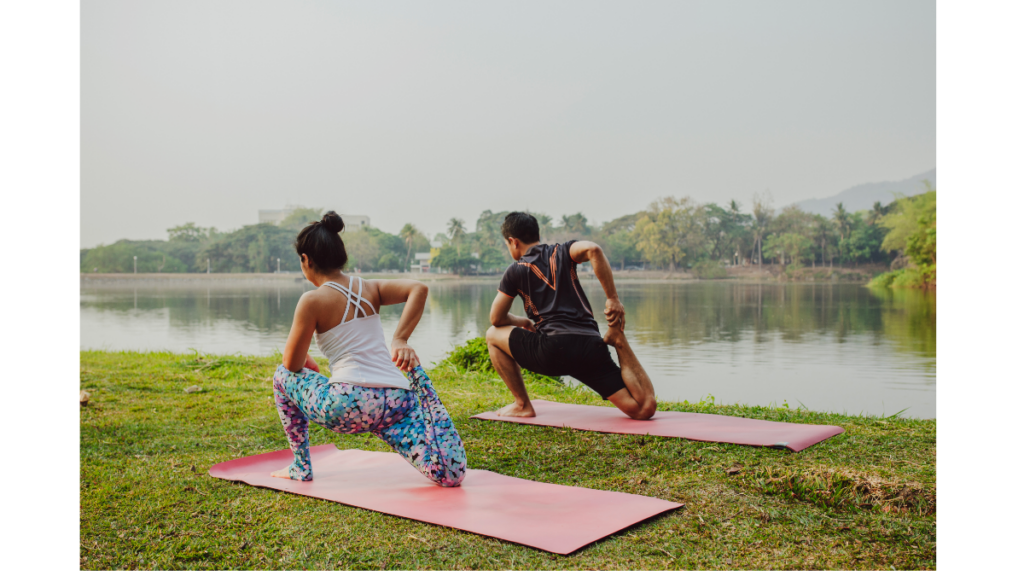Cross-country running demands more than just speed; it requires a gritty determination to power through mud-splattered trails, conquer steep hills, and push past exhaustion, all while feeling the earth shift beneath your feet with every stride. It’s a test of both muscle and mind. Athletes know the importance of taking care of their bodies for optimal performance and that includes recovery. Practicing yoga is a great way to recover and stay in tune with the body and mind.
September marks National Yoga Month, a time dedicated to celebrating the physical, mental, and spiritual benefits of yoga. For cross country runners, yoga can be a powerful tool to enhance performance, prevent injuries, and maintain overall well-being.
Cross country runners adding yoga into their training routine can experience benefits like increased flexibility, improvement in balance, and overall strengthening of key muscle groups.
It also helps with controlling breathing and boosting focus, which is important when hitting the trails.
There are many poses in yoga including specific movements and stretches that are helpful for cross country runners.
Here are the best yoga poses for cross-country runners and how they help with performance.
Tree Pose
Tree Pose is one of the best poses to practice for beginners. The pose can be done anywhere because it has the athlete performing in the standing poison.
Muscle Focus: This is a balancing pose that strengthens the legs, ankles, and core.
How To Do The Pose: To perform Tree Pose, stand tall and shift your weight onto your left foot. Place the sole of your right foot against your left inner thigh or calf (avoid the knee joint). Bring your hands together at your heart or extend them overhead. Hold for 30 seconds to one minute, then switch sides.
For runners, balance is key to navigating uneven terrain and maintaining a steady stride.
The added bonus is that Tree Pose also helps with focus because the athlete needs to concentrate on engaging the core and not falling over.
Runner’s Lunge
The Runner’s Lunge is a dynamic pose that provides a deep stretch for the hip flexors are often tight from repetitive running motion. This yoga pose also helps strengthen the legs and improve hip stability, which can help prevent knee injuries and improve running efficiency.
Muscle Focus: This pose stretches the hip flexors, quadriceps, and calves.
How To Do The Pose: To perform Runner’s Lunge, start in a standing position, then step your right foot back into a deep lunge. Lower your left knee to the ground and press your hips forward. Keep the chest lifted and back straight. Aim to stay in this position for 30 seconds, then switch sides.
Downward-Facing Dog
Downward-facing dog is one of the most well-known yoga poses. Athletes don’t need to be seasoned yogis to be familiar with the pose or be able to do it for the first time with ease.
When practicing Downward-Facing Dog, the athlete elongates muscles to get a deep stretch. It helps improve overall flexibility and reduce the risk of common running injuries, such as shin splints and calf strains. It is also great for upper body conditioning, which helps with running form.
Photo: Freepiks
Muscle Focus: This is one of the best yoga poses for stretching the calves and Achilles tendons. It also is a full-body stretch, targeting the hamstring, and the core, and strengthens the arms and shoulders.
How To Do The Pose: To perform Downward-Facing Dog, start on all fours on a yoga mat. Lift your hips up and back, creating an inverted “V” shape with your
Pigeon Pose
Pigeon Pose can be more advanced for those new to go, or have tight hips. The hip flexors become shortened with repetitive overuse, which can lead to poor running mechanics. This affects stride length and overall performance. This is why it’s important to stretch and practice yoga for cross country so that runners can stay on top of their performance and stay healthy for meets.
Muscle Focus: Practice Pigeon Pose for opening up the hip flexors and glutes. This pose also stretches the piriformis, a small muscle deep in the buttocks that can cause sciatic pain if it becomes tight or inflamed.
How To Do The Pose: Start in a downward-facing dog, then bring your right knee forward and place it behind your right wrist, with your foot angled out. Slide your left leg back, keeping the hips square. Lower your torso over your bent leg and breathe deeply, holding the stretch for 30-60 seconds on each side.
Bridge Pose
This yoga pose is ideal for cross country runners looking to tone and engage their abdominal muscles. A strong core and lower back are vital for maintaining good posture and balance, especially on uneven trails. Bridge Pose is another pose that helps to condition the full body.
Muscle Focus: Bridge Pose is excellent for strengthening the glutes, hamstrings, and lower back — muscles that are crucial for a strong running stride It also helps open up the chest and shoulders, which can become tight from poor posture during long runs.
How To Do The Pose: Lie on your back with your knees bent and feet hip-width apart. Press your feet into the ground, lift your hips towards the ceiling, and clasp your hands underneath your body. Hold for 30-60 seconds while breathing deeply.

